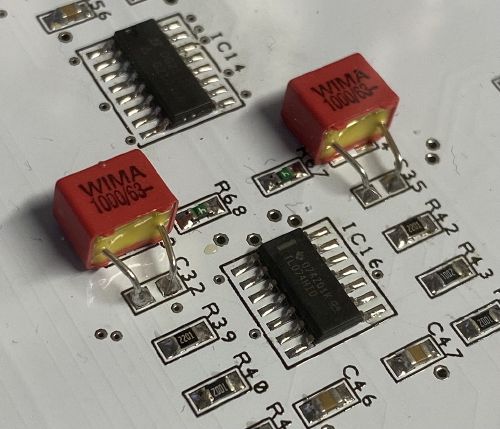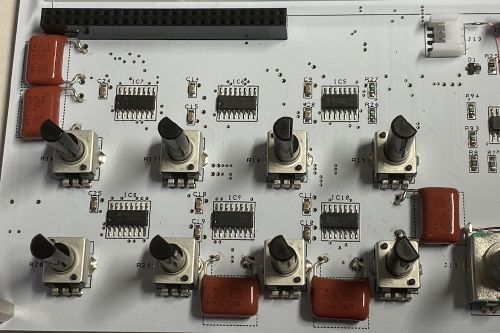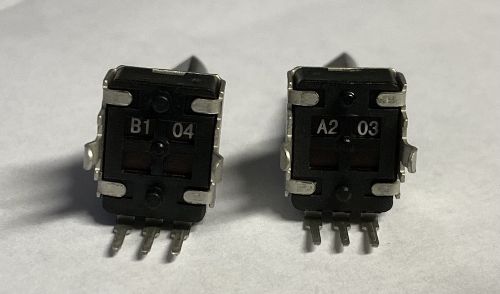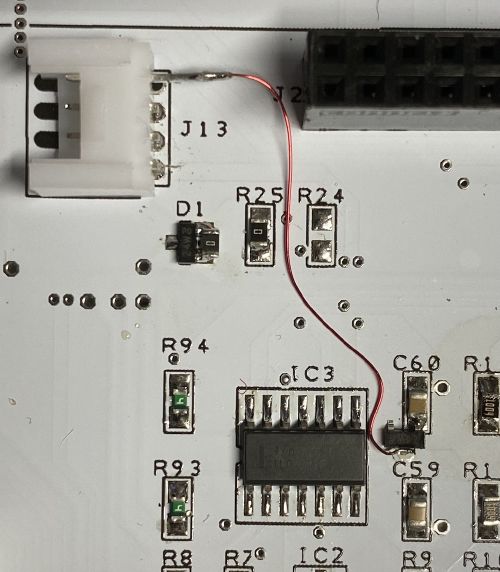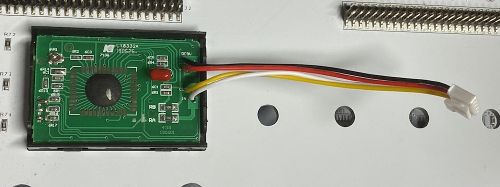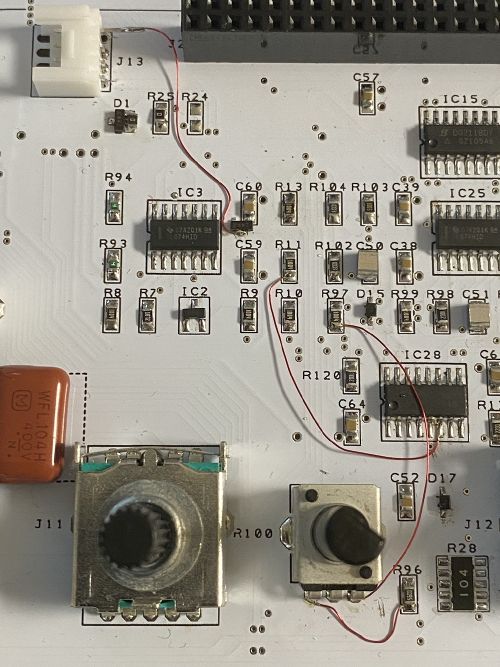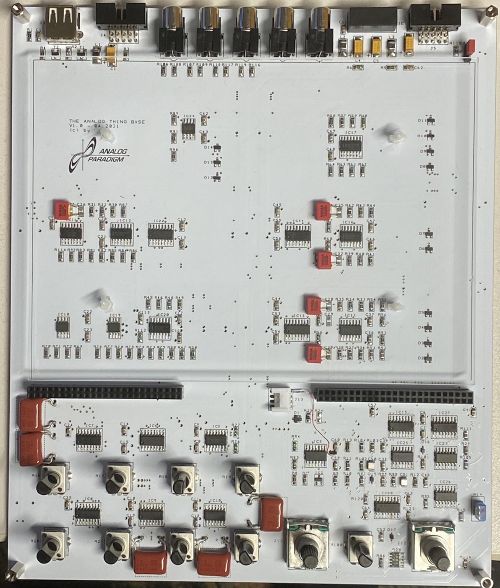Difference between revisions of "Assembly instructions"
m (+cat) |
m |
||
| Line 14: | Line 14: | ||
* Connect THE ANALOG THING to a suitable 5V source via the USB cable. | * Connect THE ANALOG THING to a suitable 5V source via the USB cable. | ||
* Now switch J12 to its fully counter clockwise position (this is MINION mode which implicitly turns on the circuit). | * Now switch J12 to its fully counter clockwise position (this is MINION mode which implicitly turns on the circuit). | ||
| − | * check that all supply voltages are present and valid: | + | * check that all supply voltages are present and valid (all voltages are measured with respect to ground which can be easily accessed at the shield of the Cinch jacks): |
** Check for -12V at pin 11 of IC25. | ** Check for -12V at pin 11 of IC25. | ||
** Check for +12V at pin 4 of IC25. | ** Check for +12V at pin 4 of IC25. | ||
Latest revision as of 13:15, 10 August 2021
The following sections describe the assembly process of The Analog Thing with BASE board revision 1.0, 04.2021. This board has some minor quirks that must be taken care of as described in the following.
Basically the assembly process is straightforward based on the bill of materials and is straightforward. The BASE printed circuit board should by assembled according to the following steps:
- First, solder in all resistors, capacitors, inductors, transistors, and diodes but leave out R120, R24, R25, D1 and C26, C28, C30, C32, C35, C27, C29, C31, C33, C34 (we will come back to these later). (A nice introduction to soldering SMD parts by hand can be found at [1] or at [2].) It is advisable to solder in each type of component at a time. All parts denoted with a * in the bill of materials are high precision parts, i.e. resistors with 0.1% of precision etc. Attention: The positive side of the 47μF capacitors is denoted by the dark stripe on the capacitor! Attention: The markings for C5 are the wrong way around on the PCB! The dark stripe of C5 must point upwards to the connector end of the BASE board!
- In the next step, solder in IC2 (LM4040x) and all connectors except the 1x4 pinhead for the connection of the panel voltmeter (we will come to this later, too). Please note that the rear connector of the Cinch connectors must be trimmed slightly with a side-cutter as the through hole in the PCB is a tad to small.
- The next step involves soldering in the DC/DC-converter IC1 (TBA2-0522).
- Solder in switch J12 (lower right).
- Solder in the trim resistor R14.
Having finished these tasks, the first test can be performed:
- Set the switch J12 to its second position from the fully counter clockwise position (this is OFF).
- Connect THE ANALOG THING to a suitable 5V source via the USB cable.
- Now switch J12 to its fully counter clockwise position (this is MINION mode which implicitly turns on the circuit).
- check that all supply voltages are present and valid (all voltages are measured with respect to ground which can be easily accessed at the shield of the Cinch jacks):
- Check for -12V at pin 11 of IC25.
- Check for +12V at pin 4 of IC25.
- Check for +5V at pin 14 of IC23.
- Check for +5V at the lower left pin of IC2.
If these tests turn out to be OK, the rest of the board can be populated with parts:
- Solder in all remaining ICs.
- Solder in 1nF WIMA PP capacitors as C26, C28, C30, C32, and C35. These are the integration capacitors for the large time scale factor of the integrators. The result should look as follows:
- Solder in the five 100nF capacitors C27, C29, C31, C33, C34 in the lower part of the PCB:
- Now it is time to solder in switch J11, and the potentiometers R16-R23 and the potentiometer R100. Attention: R100 is a 100k potentiometer with a logarithmic (!) curve while the potentiometers R16-R23 have a linear resistance curve. These potentiometers look basically identical and can be distinguished by the markings at their back. The potentiometers marked B1 are of the linear type (R16-R23) while the potentiometer marked A2 is the logarithmic potentiometer R100:
Now a minor fix must be made to allow for operation of the digital panel voltmeter (DVM). Originally the DVM should have been supplied by the +12V supply of THE ANALOG THING. Unfortunately this does not work since the inputs of the DVM are not referenced to ground (GND). To compensate for this the supply of the DVM must my changed to be symmetrical with respect to ground. By means of two Z-diodes two voltages of about +/-6V are generated which are then used to power the DVM:
- Solder in the 1x4 pinhead J13 but bend up its top pin so that it does not touch the through hole in the PCB.
- Solder in a BZX84 6V2 Z-diode in the place of D1.
- Short circuit the two pins of this Z-diode either with a short wire or with a 0 Ohm resistor.
- Solder a second BZX84 6V2 Z-Diode with its anode to the bottom connection of C60 (as shown below) and connect its cathode with a thin wire to the topmost pin of the 1x4 pinhead connector. The result should look like this:
- Now it is time to solder the four connector cable to the DVM. In addition this bridge P3 on the back of the DVM must be opened and P1 must be closed to set the decimal point to its correct position:
- Do not yet connect the DVM to the BASE board. Connect the base board to a USB power supply and turn switch J12 to its leftmost position thus turning THE ANALOG THING on (MINION mode). Now measure the voltage at the top two pins of the 1x4 pinheader for the DVM against ground (one pin at a time). The top most pin should read -6...V while the second pin from top should read +6...V (the exact value is not important, it should be around +/-6V).
There are two additional patches to perform:
- R100 is connected the wrong way around, so the scale does not match the value set. To change this, cut through the two traces connecting the left and right pin of R100. Then connect these two pins with thin patch wires crosswise with the cut traces.
- The fast repetitive mode (REPF) does not work without another tiny change: Cut through the trace leading to pint 6, IC28. Connect pin 6, IC28, with a thin wire to the lower end of R11 as shown below:
The remaining steps are:
- Install the four plastic spacers on the BASE board and snap in the pre-drilled plexi-glass sheet.
- Install the four hexagonal spacers in the corners of the BASE board:
- Snap the DVM with its attached four connector cable into the FRONT PCB.
- Connect the DVM cable with the 1x4 pinheader J13.
- Mate FRONT and BASE PCBs (the two 50 pin connectors require some patience as well as some deliberate but careful force to fully close).
- Secure the FRONT PCB with four screws in its corners.
- Plug the knobs to the axes of the switches and potentiometers.
That's it! You should now have a fully working ANALOG THING. :-)
Next thing you certainly want to do is Testing.
